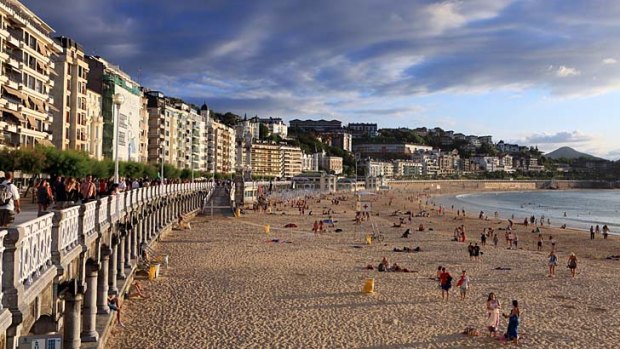
Basque delight: La Concha beach.Credit: Getty Images
Food, wine, sun and fun. San Sebastian is the capital of the excess.
We're in the Basque town of San Sebastian on a Friday night and it's as if the whole city has been turned upside-down by some benign giant, with every person shaken out of every apartment, all ending up in this one tiny, joy-filled, people-filled street. Via much convivial mingling, we're drawn deep into the nearest bar - a tiny space called Txepetxa, so crowded it feels like one of those Guinness World Records challenges in which 23 uni students try to fit into a Volkswagen.
Catching the eye of the bartender, I order a glass of wine - reasonably priced at a couple of euros - and point to a pintxo (pronounced pincho), the Basque version of tapas. Both are superb - the white wine crisp and zesty, the pintxo an amazing concoction involving anchovies and spider crab (anchoas con centolla). I am in a boisterous foodie heaven. I look at my companion and say: "I can die happy. This is perfect. I never want to go anywhere else in my life."
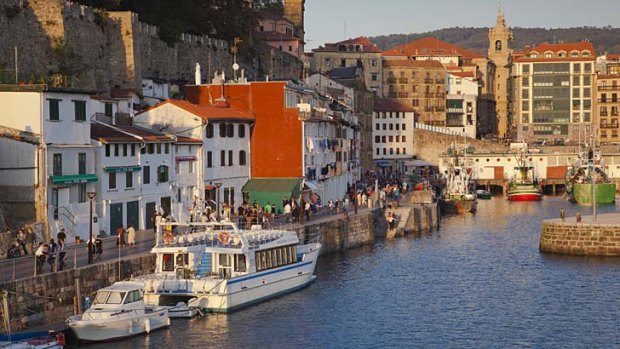
The San Sebastian waterfront.Credit: Getty Images
But wait! No lingering! There's more! The custom here is to bolt down one or two rounds of this wine/pintxo combination, then head back into the fray, down the packed street to the next bar, which could be as far as two doorways away. Naturally, it's a thirst-inducing hike, and more wine and pintxos will be required.
If you follow the local custom, you will eat and drink at three or four establishments, from about 8pm to 10pm, downing six or eight food/drink revivers, at which point you can reasonably present yourself at a restaurant for dinner.
We choose a place called Narru. Once we are inside, all the crowds disappear. We find ourselves suddenly alone. I can hear the clock ticking in the hallway. I can hear the sound of the chef putting on his apron in the kitchen. I feel like crying with loneliness. I eat the crunchy bread, the sound of my teeth on the crusty bits echoing around the empty restaurant. We stop talking to each other because it feels too weird.
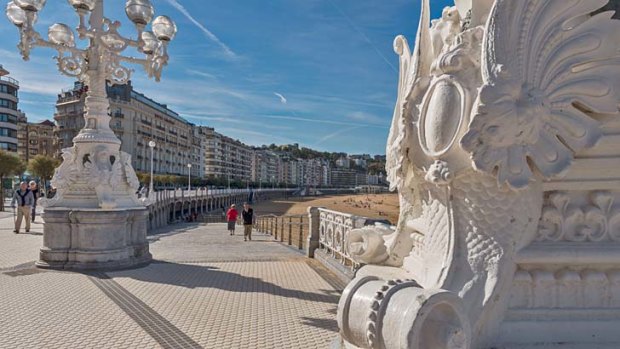
The seaside promenade at La Concha beach.Credit: Getty Images
This is because we have arrived at the ridiculously early hour of 10pm. The waiter fusses over us in a kindly fashion, trying not to make us self-conscious about our gaucheness. For our main courses, we order costillar de cordero lechal cocinado a baja temperatura (rack of lamb) and pescado del dia asado patata y oliva (baked fish), and then we wait. At 10.30pm, the rest of the street suddenly decants itself into the restaurant, all chatter and scraping chairs and frenzied hugging. They then, as one, all noisily demand food, it having been three minutes since they last ate. Ah, bliss, we are back in the noisy gregarious heaven called San Sebastian.
THERE'S something fabulously playful about San Sebastian. It's self-consciously a holiday town; a tasteful, foodie pleasure dome that is serious about having fun. Its elegant buildings are set along one of the great beaches of Europe, a deep, semi-circular stretch of fine, soft sand called Playa de la Concha. Some of these graceful buildings are hotels and high-end stores; a great number are restaurants. As the locals like to boast, it's a town with more Michelin stars per head than anywhere else in the world.
It was a fishing port - and pawn in various conflicts - until the late 19th century. At this point the Spanish queen became sick of being the odd one out at gatherings of European royalty, twiddling her thumbs while the other queens twittered about visiting their own fabulous resorts. "I'd like what she's having," said Queen Maria Cristina, or words to that effect, whereupon San Sebastian was transformed into a Belle Epoque watering hole for European royalty.
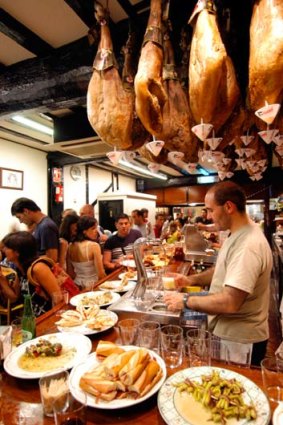
Boisterous foodie heaven involves pintxos and wine.Credit: Alamy
The sea is an extraordinary inky blue, the sand golden, and the locals gambolling on the beach have surely been vetted as to their attractiveness. There's an island one-third of the way across the bay, as if it were photoshopped into the perfect position. On one headland stands a giant statue of Christ and on the other a delightfully retro children's amusement park, full of ancient, clanking boat-rides and ghost caves, reached by an old funicular railway.
At the northern end of the beach, there are tiny seafood restaurants huddled into the headland, and a large restaurant-bar built in the shape of a ship, all funnels and portholes, as if it had come aground in a storm. Further along the beachfront, many of the grand houses are theatrically turreted or castellated as if to emphasise that the main point of the place is frivolity.
The town, it is said, had a dip in fortunes after World War II, but the famous film festival was added to the mix in the 1950s - effectively replacing the old royalty of the 19th century, with the new royalty of Hollywood. These days, some of the restaurants display photographs of the various stars who've eaten at their establishment, the photos nestled around the blackboard menu. You may have to control the urge to summon over the waiter: "I'll have the grilled tuna, and my wife will have the George Clooney."
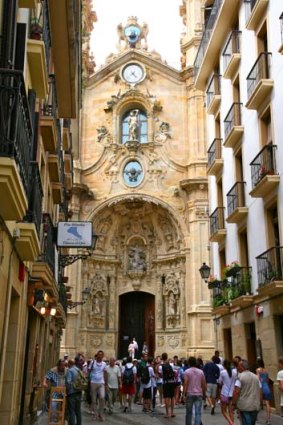
The Church of Santa Maria.Credit: AFP
BACK at the Narru restaurant on our first night in town, the clock has hit 10.45pm, and the service has become phenomenally fast. An appetiser is brought, the next course chasing it down the straight, the dessert bringing up the rear. It's as if the waiter just looked at his watch and said: "My god, look at the time - don't these people realise it's nearly 11pm?"
The food is amazing and the speed of the service doesn't detract from its attentiveness. We'd confessed we intended to share our mains, so the waiter emerged from the kitchen with each dish divided into two portions, separately plated and artfully arranged.
For dessert we saved him the trouble by both ordering the torrija de brioche de mantequilla, crema y helado de cafe - a sort of custardy French toast that makes you want to marry the chef.
By about 11.15pm we were staggering towards bed with a full stomach - something that seems to suit the Spaniards fine. I once asked a Spanish friend about the whole timing of dinner, and she confessed that, upon her migration to Australia, she patriotically attempted to shift her body clock to a 7pm dinner. She shook her head sadly. "But by the time I went to bed I was sooooo hungry."
For those without Spanish stomachs, the going might be a bit tough once you tumble into bed.
There may be a slight restlessness during your slumbers in which you wonder whether it was necessary to try to eat all the food in San Sebastian, and to personally consume all the town's supplies of wine, leaving exactly nil digestion time before you fell asleep. Yet who ever said travel was meant to be easy? Eating and drinking yourself silly in San Sebastian is an important cultural experience, and you'll just have to knuckle down.
We decide to walk it all off the next morning by taking a rough mountain track, over hills and around the bays, with spectacular views over the Atlantic. I note with some apprehension that the path leads to yet more restaurants. Surely we will never be able to eat anything at all, ever again in our lives.
The walk from San Sebastian to Pasajes takes about three hours, the path-maker presumably in the pay of the restaurants, as the track takes every opportunity to snake up the steepest part of the hill in a manner designed to make you realise that, yes, perhaps, a small morsel of food might be possible once you reach the town. We tramp through lovely forests, and then across meadows with views of farms, then around a bend featuring an ancient Basque aqueduct.
Always to the left, is the Bay of Biscay, shimmering. There are detours, should you wish to take them, down to tiny beaches or up to old lighthouses. By now though, surely, you'll be peckish and keen to press on to Pasajes.
A long stone stairway, built into a cliff face, leads to the town. There's a handsome harbour, protected by two arms of rock that sweep together to create a perfectly sized slot though which the fishing boats come and go.
At the bottom of the staircase, a small ferry chops back and forth across the harbour, allowing you to disembark and choose somewhere to eat - anything from Michelin-listed seafood restaurants to cheap cafes.
We become indecisive. We settled into one before becoming woozy from the fumes of disinfectant - the only time I've ever left a restaurant because it seemed too clean. We then considered one of Michelin places, before becoming woozy from the prices. A small seafood cafe in the main square was perfect - local anchovy fillets, followed by a bowl of fish stew, washed down by a couple of glasses of cheap, cold white wine.
To get back to San Sebastian you can walk, catch the bus (as we did), or, given how much you've eaten, hop back to the top of the mountain and try rolling.
AFTER a hike across the hills in the morning and then an afternoon at the beach, you may realise it has been hours since you last ate anything. The pintxos bars beckon once more. This time around you may like to consider going with a guide. A company called San Sebastian Food runs regular tours - a handful of visitors teamed with a local guide. Part of the experience of the bars is sharing conversation, and the tour has the advantage of setting you up with some English-speaking companions.
Pintxos come as either hot or cold dishes, and while the cold are often lined atop the bar and easy to order via pointing, the hot dishes can be harder to decipher from the scrawls on restaurant chalkboards. We join a tour led by local gourmand Lourdes Erquica.
It isn't cheap at 95 euros each, yet it was a fabulous experience, with all the food and wine included in the price. Lourdes provided a breezy history of the town, a deep knowledge of local culinary practice, and a good sharp elbow when access to the bar was required.
In the space of a few hours we have anchovies with blueberries, prawn skewers, smoked cod, red peppers stuffed with tuna, a serve of slow-cooked beef, suckling pig, octopus and even a pintxos dessert in the form of a tiny, delicate cheese cake, each dish matched with local wines. The tour also includes a peek inside one of San Sebastian's "gastronomic societies". There are scores of these private clubs, consisting of not much but a commercial kitchen and a few tables. In a town of tiny apartments, members use the society's kitchen to entertain friends.
Membership of most of the societies is open only to men, although women can usually attend.
You may think men cooking for women is quite a feminist achievement. Perhaps that's true - although you should know the profit on the booze goes to provide a cleaner who comes the next day to wash the dishes, sweep the floors and clean the ovens. At this point in the proceedings the ban on women being involved is enthusiastically lifted. As we wander back to the hotel, the moonlight glistens on the water of that extraordinary bay. Locals walk in sociable groups, chatting as if the night were only just starting.
It really is a town built for fun and enjoyment. The beach. The bay. The food. And the chance to occasionally walk it all off on tracks around one of the most spectacular coastlines in Europe.
The locals seem to have a party every night. It seems rude not to join them.
The writer travelled at his expense.
ABOUT THE WRITER
Richard Glover is a popular Sydney-based broadcaster, author and veteran weekly columnist for Fairfax Media. This is his first feature for Traveller.
TRIP NOTES
GETTING THERE
Thai Airways has a fare to Madrid for about $1945 low-season return from Melbourne and Sydney including tax. Fly to Bangkok (about 9hr) and then to Madrid (13hr 40min). Phone 1300 651 960 or see thaiairways.com. Iberia/Air Nostrum has a fare from Madrid to San Sebastian for about $220 return including tax for the 75- minute flight. You can also take a 5-hour train ride between both cities for about $40 second class. Australians do not require a visa for stays of up to 90 days in a 180-day period.
STAYING THERE
The well-appointed and stylish three-star Hotel Niza is on the beach, with a startling view across the bay. Downstairs at the hotel is Narru, a restaurant that revs up after 10.30pm. See hotelniza.com.
MORE INFORMATION
Sign up for the Traveller Deals newsletter
Get exclusive travel deals delivered straight to your inbox. Sign up now.